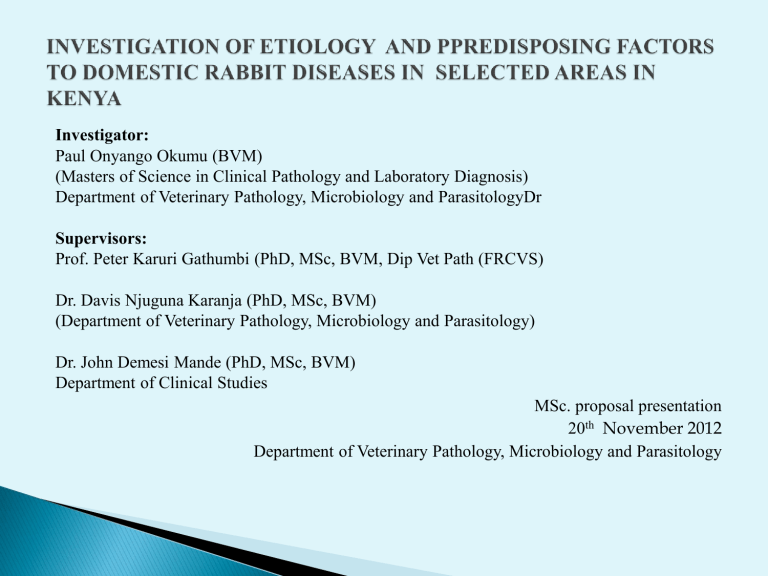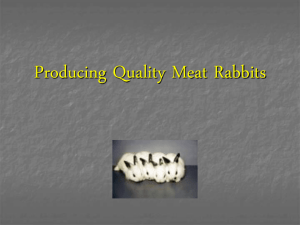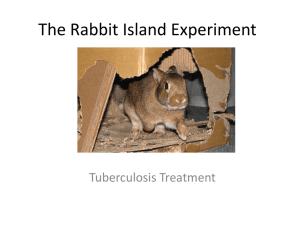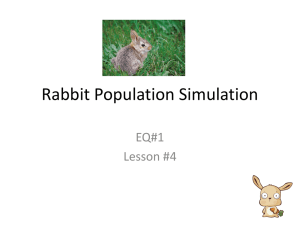MSc. Proposal present.-Investigation of rabbit diseases

Investigator:
Paul Onyango Okumu (BVM)
(Masters of Science in Clinical Pathology and Laboratory Diagnosis)
Department of Veterinary Pathology, Microbiology and ParasitologyDr
Supervisors:
Prof. Peter Karuri Gathumbi (PhD, MSc, BVM, Dip Vet Path (FRCVS)
Dr. Davis Njuguna Karanja (PhD, MSc, BVM)
(Department of Veterinary Pathology, Microbiology and Parasitology)
Dr. John Demesi Mande (PhD, MSc, BVM)
Department of Clinical Studies
MSc. proposal presentation
20 th November 2012
Department of Veterinary Pathology, Microbiology and Parasitology
Rabbit production is now one of the fastest growing livestock enterprises in the world. highly prolific, early maturity, fast growth rate, high genetic selection potential, efficiency in feed conversion and economic utilization of space
(Lukefahr & Cheek, 1990)
The estimated rabbit population in Kenya is at
600,000 (APD, 2010)
Rabbit Development Stakeholders Forum (RDSF) was established to spearhead a national campaign to promote rabbit production and consumption.
challenges to production Are: Diseases, feed cost, market, sources of breeds (APD, 2010)
Knowledge on rabbit diseases is an important gap among existing veterinary practitioners in Kenya
(Borter et al., 2010).
Rabbit Diseases
Gastrointestinal, Respiratory, Skin,
Reproductive, metabolic and nutritional diseases
and disorders and miscellaneous conditions.
(Martino and Luzi, 2008, Cooper 1973).
ETIOLOGY O F GASTROINTESTINAL DISEASES
Bacterial diseases
Colibacillosis, Salmonellosis (Cooper,
1973).
Escherichia coli and Salmonella spps
Protozoal diseases intestinal coccidiosis (Aleri et al.,
2012), and hepatic coccidiosis
Toxoplasmosis and Cryptosporiodiosis
Eimeria spps
Viral diseases
Toxoplasma gondii and
Cryptosporidium parvum
Adenovirus, Rota virus, corona viruses and Rabbit calicivirus (RCV)
ETIOLOGY OF GASTROINTESTINAL DISEASES
Complex enteritis
Mucoid enteritis/ Mucoid enteropathy
Helminthes
Non infectious conditions
Combination of bacteria, toxins, dietary irregularities and or obstructions of git pin worms (Trichuris and Passalurus
spps), Trichostrongylus spps, flukes and tapeworms.
bloat (Aleri et al., 2012)
Stressors(weaning, transportation,, feed changes, antibiotics and Moldy feed.
ETIOLOGY OF RESPIRATORY DISEASES
Bacterial agents Pasteurella spps, Bordetella spps, klebsiella spps, staphylococci spps,
streptococci spps and rarely Escherichia
coli, salmonella and listeria.
Viral diseases others myxomatosis, herpes virus and paramyxoviruses
Helminthes, Aspergillosis
ETIOLOGY OF SKIN DISEASES
Fungal diseases
Dermatomycosis/ trichophytosis caused
Trichophyton, Microsporum, Achorion
Ecto-parasites
Mange
Ear canker lice and fleas ,
Mange mites like Sarcoptes spps and
Notoedres cati, Cheyletiella parasitovorax
Psoroptes canaliculi
Bacterial diseases
Dermatitis and abscesses
Pasteurella spps, staphylococcus, and streptococcus species
Foot pad abscesses and
Sore hocks
Viral diseases
Non specific bacteria, predisposed by breeds, wet , dirty hutch floors, and irritating action of urine salts
Papilloma viruses, rabbit pox virus and
Leporipoxvirus
NUTRITIONAL DISEASES Vitamin A deficiency, Vitamin E deficiency and hypervitaminosis A, hypervitaminosis D and Pregnancy toxemia “ketosis
NEOPLASTIC DISEASES: Pituitary Adenoma, Thymoma, fibroma,
Squamous cell carcinoma,
REPRODUCTIVE DISEASES AND
DISORDERS
Mastitis, Bacterial Metritis
Vulvovaginitis
Rabbit syphilis or vent disease,
CONGENITAL OR HEREDITARY
DISORDERS
MISCELLANEOUS CONDITIONS
OTHERS ( rare)
Staphylococcus aureus and Pasteurella
spps, Chlamydia spps
Proteus spps
Treponema cuniculi
Sterility, twisted uterus, Delayed birth,
Parturition outside the nest box, prolapses of the vagina and even abandonment of the litter
Glaucoma (Buphthalmia), Malocclusion and tooth over - growth or “wolf teeth,”
Splay leg and ataxia)
Trichophagy, trichobenzoars, cannibalism, heat prostration, broken back and intussusceptions
In Kenya, Cooper (1973) concluded that all diseases of rabbits recognized elsewhere in the world exist in Kenya.
Respiratory and gastrointestinal conditions as the most common (Ngatia et al., (1988)
Diseases of rabbits in Nairobi have increased tremendously by the year 2010 Aleri et al., (2012).
Little has been done to find out the causes of mortalities and Morbidities of domestic rabbit
(Wesonga and Munda, 1992; Cooper, 1973)
Reasons: Knowledge gap, inadequate connection between field diagnoses and confirmatory laboratory diagnoses (Borter et al., 2010)
Overall objective
To determine the characteristics diseases that constrain rabbit production in Kenya
To characterize the rabbit production systems in relation to disease burden in Nairobi, Central,
Eastern and Rift valley regions of Kenya.
To determine the etiology of rabbit diseases in domestic rabbits in the selected areas of Kenya
To determine the predisposing factors associated with rabbit diseases in the selected areas of Kenya
The National livestock policy , Government
Vision 2030 and Millennium development goals
(MOLD, 2008) aim to eradicate extreme poverty and hunger and achieve food security.
Mailu et al. (2012) recommendation on promotion and development of rabbit supply chain in Kenya.
Stresses on the need to asses important aspects such as diseases, marketing, consumption and breeds of rabbits kept.
The aim of this study is to carry out an assessment of rabbit diseases, their etiology and predisposing factors. This will avail the basic information needed to constitute their control measures and improve rabbit production
5.0. HYPOTHESES
Diseases that limit rabbit production in Kenya are predisposed by poor hygiene within the farms
6.2. study Area
The cross sectional survey will be done in:
Kiambu, Thika, Nyeri, Othaya, Mukurweini, karatina, Gilgil, Nakuru, Meru, Taita and
Wundanyi which are selected to represent
Central, Eastern, Rift valley and Coast provinces rabbit producing areas
6.3. Choice of farm, animals
The study will involve a purposive sampling of sick, moribund, dead and or rabbits with disease history.
384 rabbits will be examined as determined by the method described by Martin et al. (1987):
N = Z²α X PQ/L²
Where N = Number of rabbits to be examined
P = Prevalence of diseases estimated at 50%,
Q = 1- P, L = desired Precision at 5% at confidence interval of 95%.
The farms to be visited are those with more than 5 adult rabbits. hence number of farms to be sampled are 77
(384/5) farms.
The locations of the farm will be purposefully determined through the assistance of livestock production officers of each area.
On farmers consent, , at least one sick rabbit from each farm will be selected and transported alive to the lab for blood sampling, necropsy, parasitological and microbiological examination.
On farm sampling of blood for parasilogy- faecal samples and skin scrappings, Bacteriology- nasal and conjuctiva swabs, haematologyblld smears and EDTA blood will be done
◦
◦
◦
◦
◦
Sampling frame
Objective 1: To investigate the impact of housing and husbandry systems on the health and welfare of farmed domestic rabbits
In each Random clinical examination. (bucks and does and weaned kits). First 50 rabbits and 10% of the remaining.
Information to be obtained include: body condition, skin and hair quality; sanitary, feeding and evaluation of hygiene and routine management procedures
Criteria recorded in a Clinical sore card and observation sheet.
Questionnaire on rabbit husbandry practices will be administered to each farmer
Objective 2: To investigate the etiology and pathology of diseases causing morbidities and mortalities in domestic rabbits
At farm
Bacterial agents
Deep nasal swab, conjuctival swab, wound swabs placed in transport media put in cool box for microbiological isolation and identification as described by Carter (1979) macroscopic characteristics of colonies , Gram staining, catalase activity, oxidase and coagulase test with rabbit plasma, TSI.
Parasitological techniques a.
Fecal and gastro-intestinal parasites samples of fresh feces will taken from the litter and under the cages, for rabbits housed in groups 3 samples will be taken in different areas of the building(s) for "MacMaster counting technique
(Sinkovics et al.,' 1984). To reveal nematode eggs and identify coccidia oocysts
For positive cases fecal culture and sporulation of the oocyst to identify the coccidia species.
Helminthes will be preserved in 70% ethanol and identified according to Soulsby (2005)
b. Skin samples
Both deep and superficial lesions will be collected from animals with skin lesions skin scrapings will be digested in 10% potassium hydroxide, analyzed and mites identified as per the key given by Soulsby (2005), Isolation of fungi in SDA (carter 1979)
External parasites will be preserved in 70% ethanol and identified Soulsby (2005)
c.
Hemoparasites
At farm level blood smears will be made, fixed for
Giemsa staining and examination.
At the lab 2ml blood will be collected from marginal ear vein and placed in EDTA for CBC, determination using the automated method
(Haematology, Analyzer)and relative differential count for leukocytes
Necropsy
The rabbits will be will be humanely euthanized
( Appendix 1) and necropsy done as per the macroscopy protocol in the Department VPM
University of Nairobi
Routine sampling of the following organs liver, lungs, kidney, spleen and any other organ if findings give reason to. For microbiological and histopathological examination.
These samples will be fixed in 10% formalin, for at least 48hours and processed for routine histopathological observations as described by
Luna (1968),
Data management
The data will be entered into Excel spread sheet and analyzed using SAS (Statistical Analytical System)
2002 – 2003 (SAS Institute Inc., Cary, NC, USA) for descriptive statistics, correlation between the husbandry practices and health status.
Research activities
Dec.
2011
Jan.
2012
Field survey
Clinical cases and laborator y diagnosis field sampling
Thesis writing
Thesis defense
July.
2012
Dec.
2012
Jan.
2013
Apr.
2013
May.
2013
July.
2013
Expendable items
Laboratory reagents and lab supplies
Field reagents and equipments
Cost (ksh)
300,000
Printing
Printing cartridge
Travels
100,300
Literature document/information 5,000
Software and statistical packages 15,000
Stationary
2,000
3,000
Subsistence-field work per diems 100,000
Transport-rental car/fuel 110,500
Sub- total
Contingencies (5% of total)
635,800
31,790
Grand Total 667,590
All the animals used in the study will be handled humanely, identified using picric acid, and transported in ventilated boxes
The rabbits will be housed individually and cared for according to the guidelines by the ARRP (2003) for not more than 3 days. Euthanasia by stunning and neck dislocation after sedation with xylazine at 5mg/kg i.m. The carcasses will be disposed in the disposal pits. cages disinfected using 10% formalin.
Thanks for listening
Comments
Questions?









